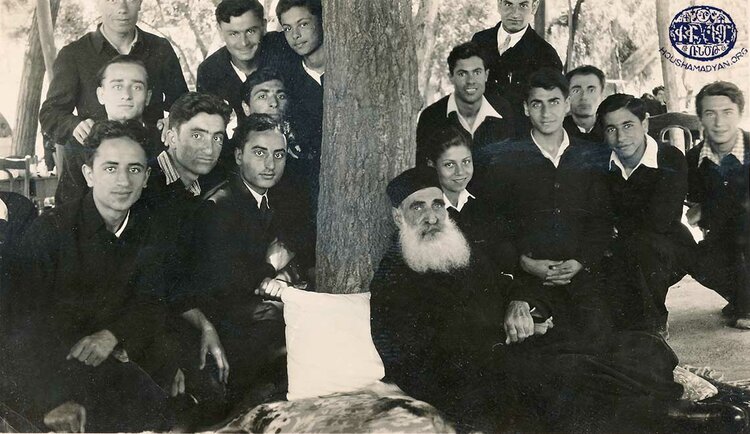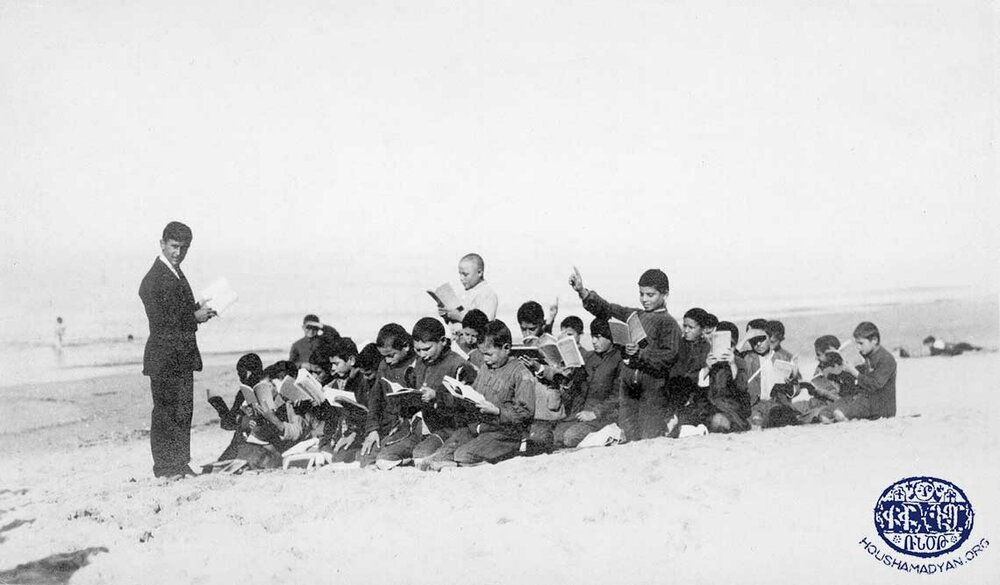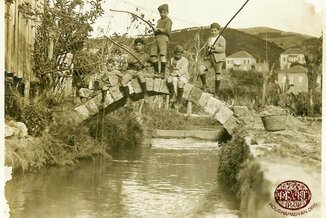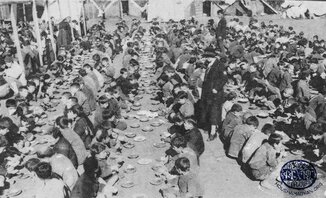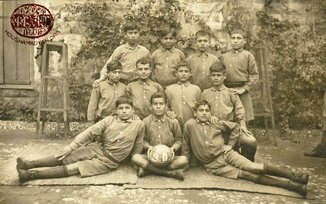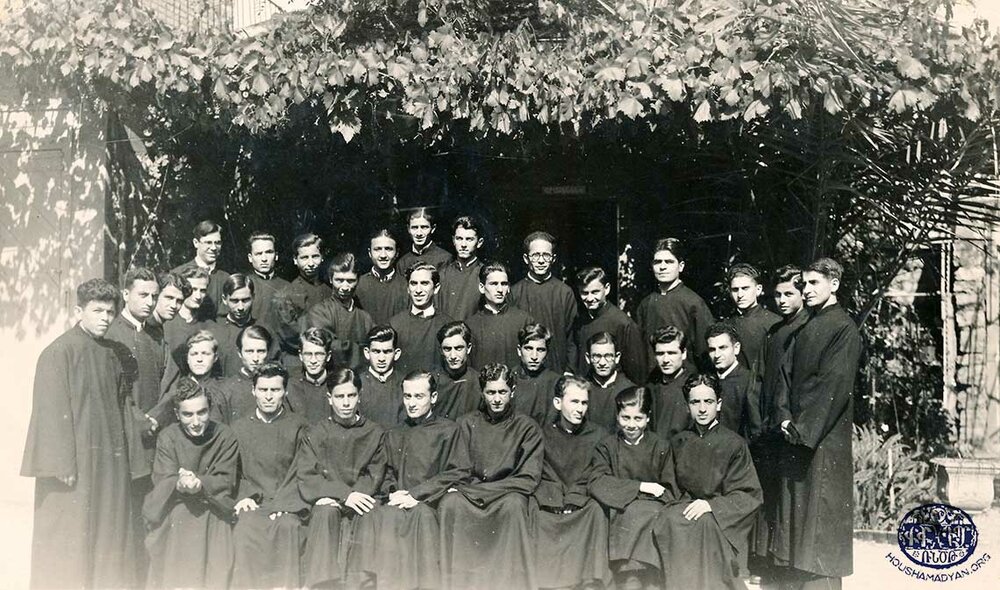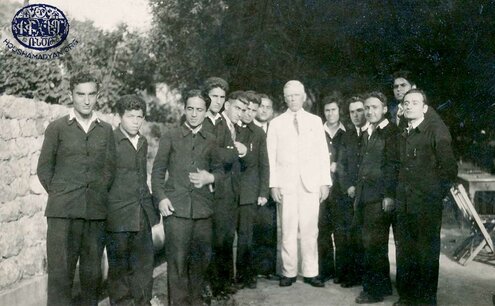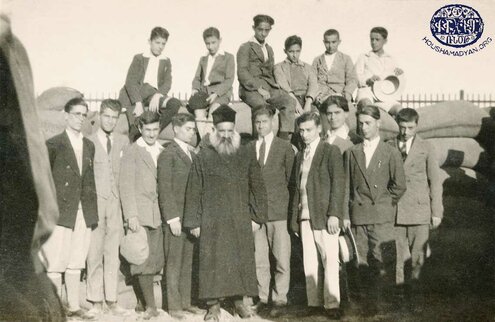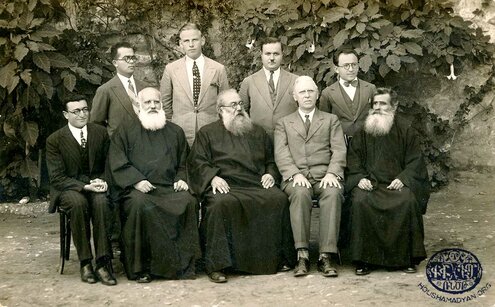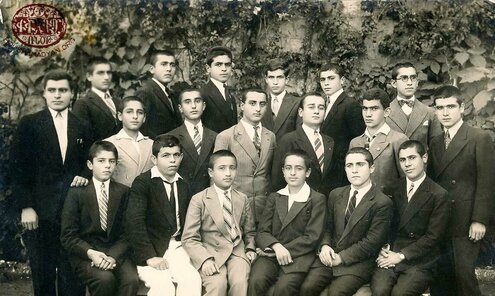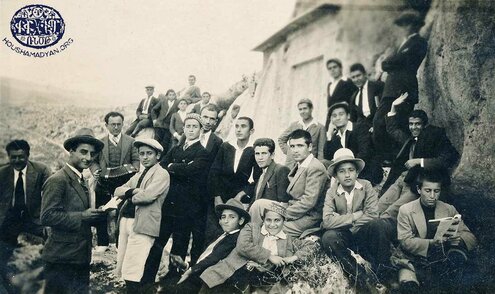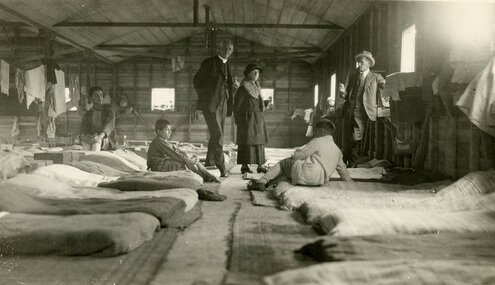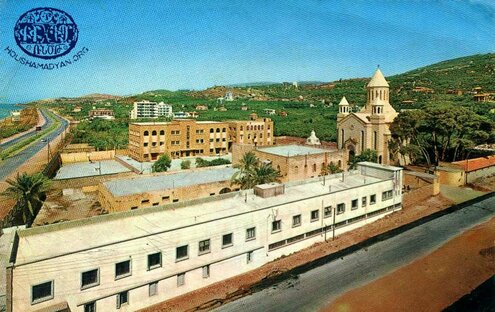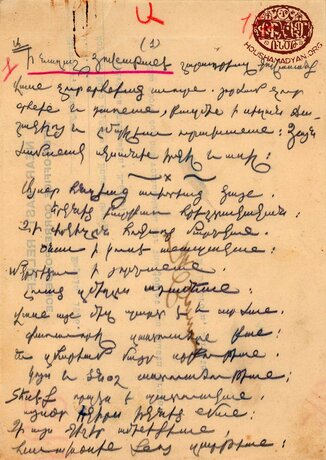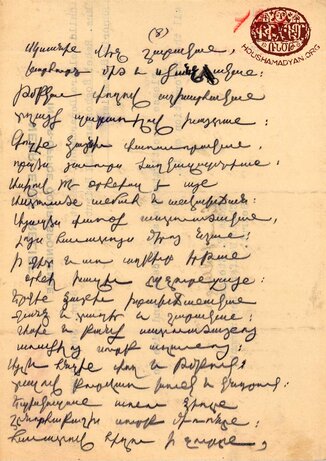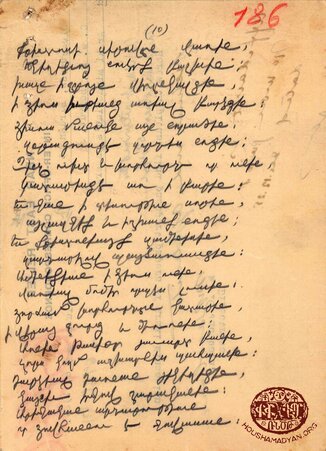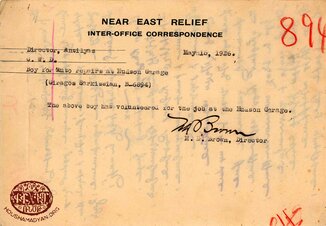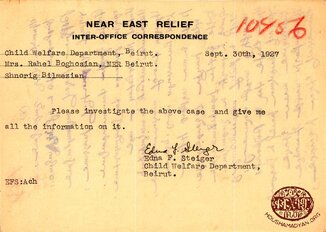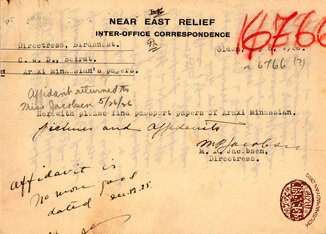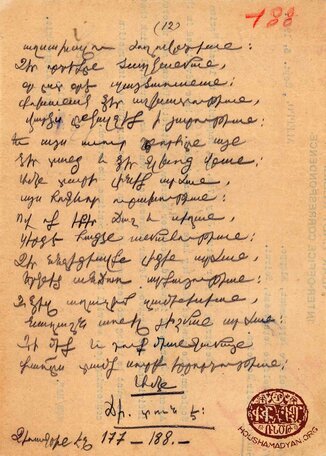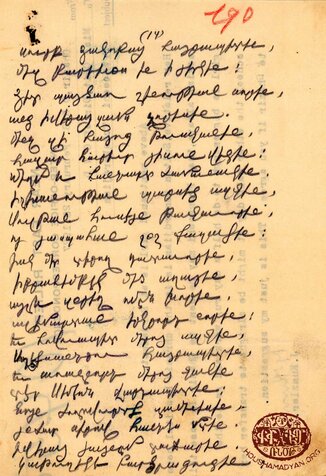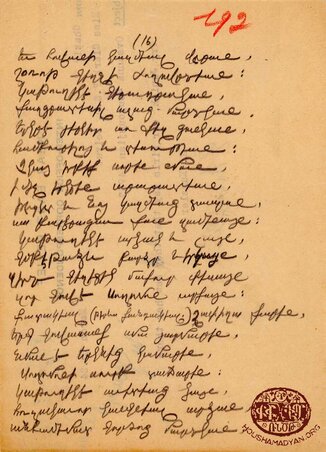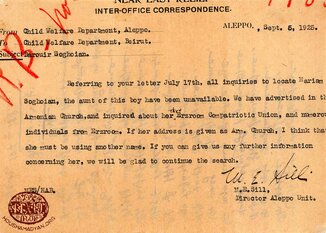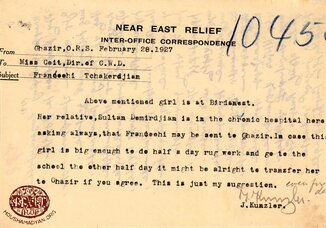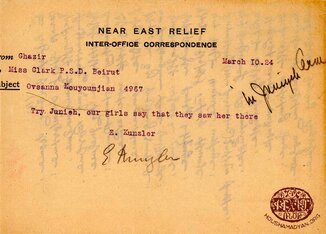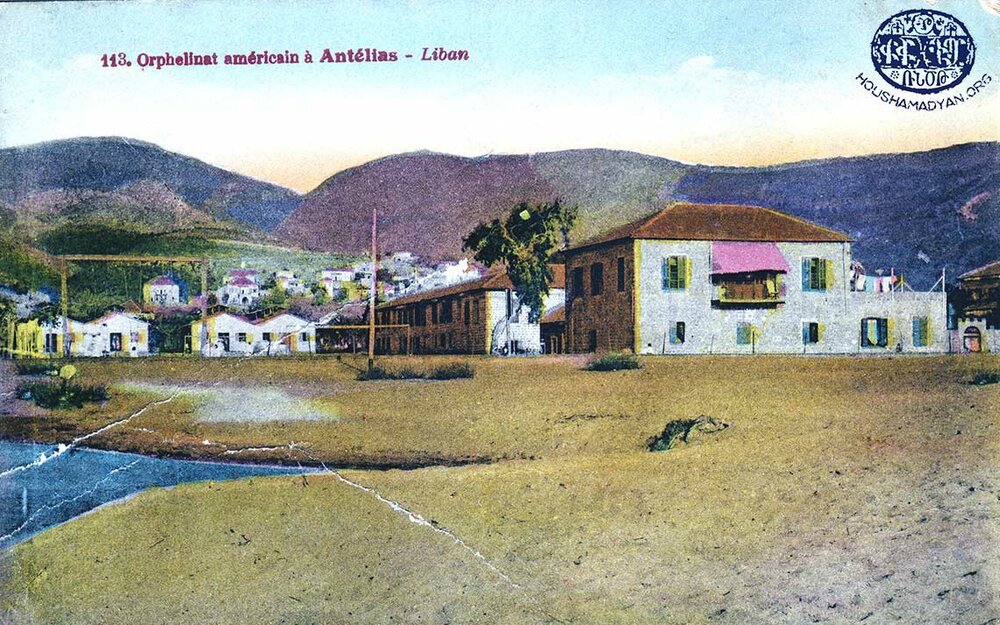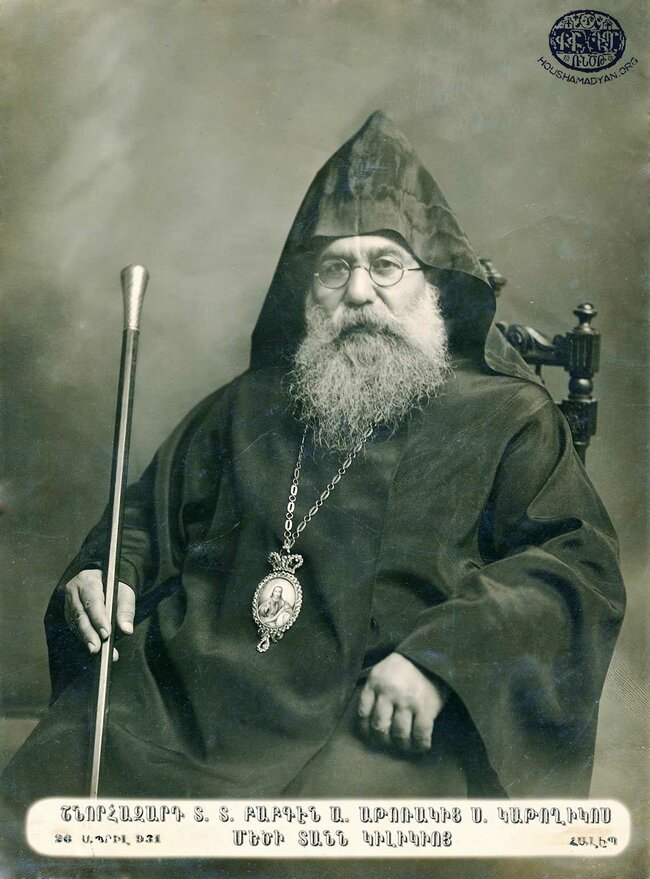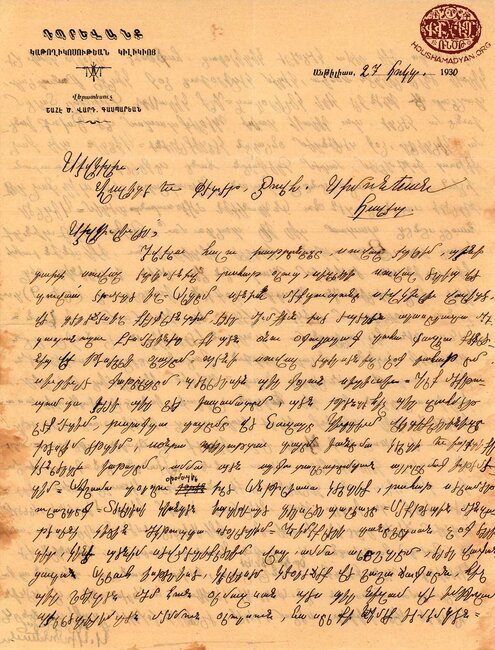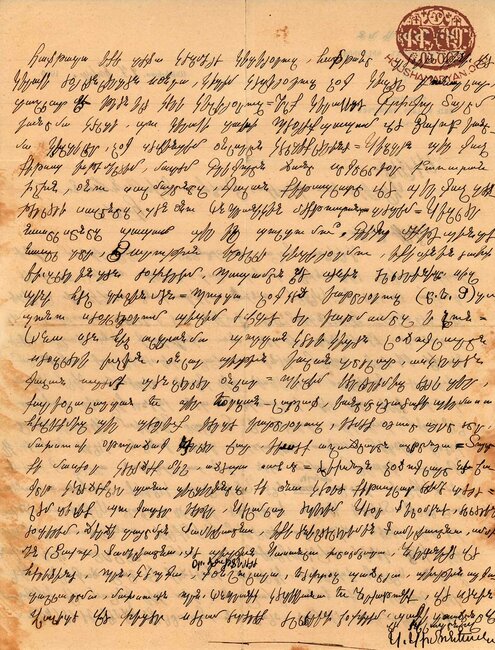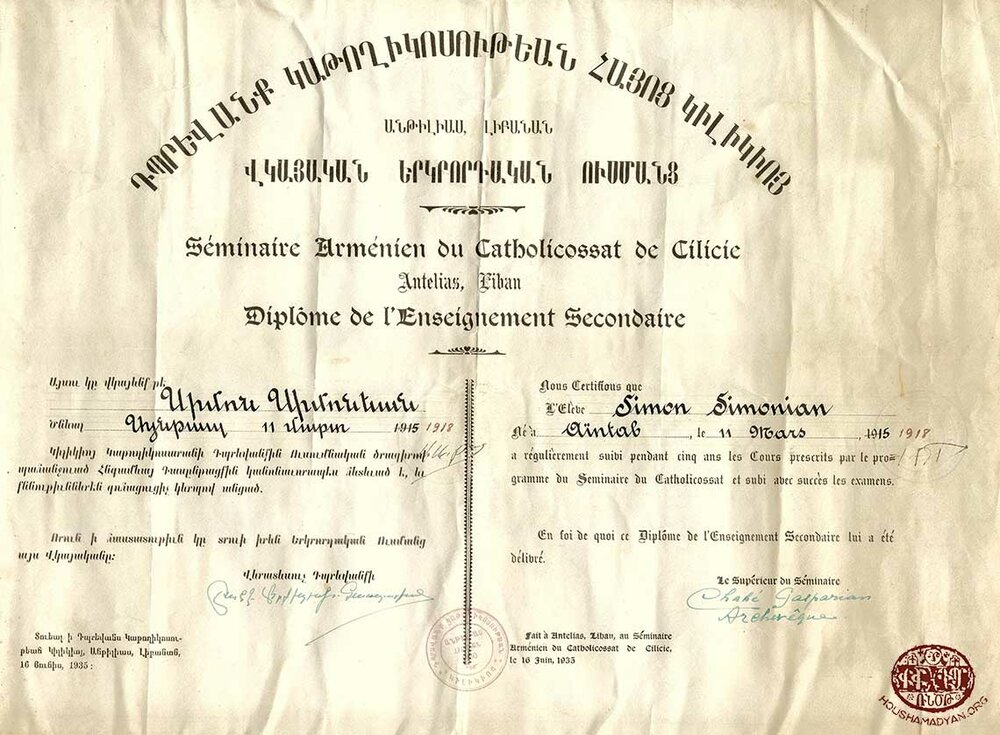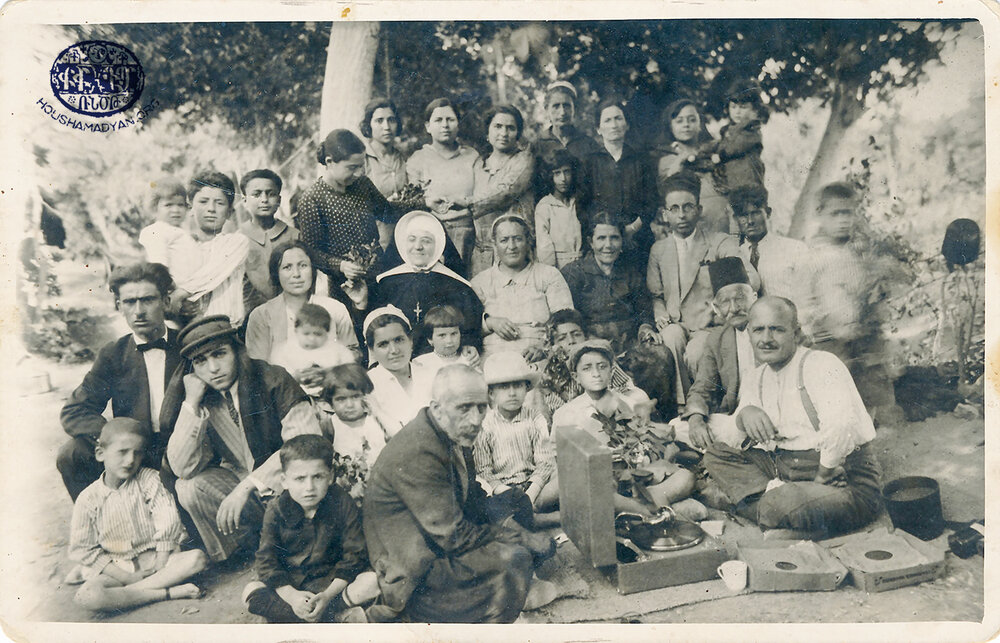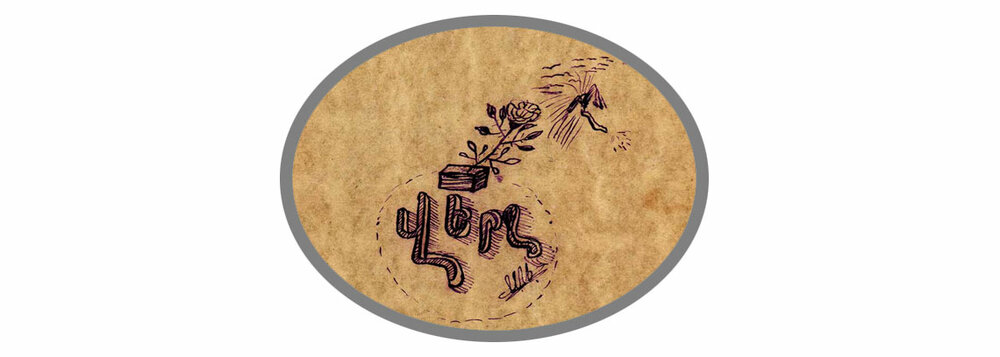Simonian collection – Antelias, Lebanon
Simon Simonian's student years at Tbrevank: 1930s, Lebanon
Author: Nora Sarafian–Tashjian, 03/07/21 (Last modified 03/07/21) - Translator: Hrant Gadarigian

In 1930, the Catholicosate of Cilicia, deprived of a permanent base for nine years, was established in Antelias, Lebanon. The property was transferred to the Catholicosate by the Near East Relief (NER), which had previously used it as a shelter for Armenian orphans (1921-1928).
In September 1930, Catholicos Sahag Khabaian arrived in Antelias from Aleppo, and at the end of a month, together with Catholicos Coadjutor Papken Gyuleserian, inaugurated the Seminary (Tbrevank) to prepare clergy and teachers for the Armenian communities.
Senior Priest Shahe Kasbarian (later Archbishop) was appointed administrator of the seminary.
The seminary’s inaugural year opens with 38 students. They had been selected based on passing written examinations in the subject areas of linguistics, education, science, and history as well as on a certificate of good conduct from the Curacy, medical documentation, and personal visits along with oral examinations.
During the first year of Tbrevank, Papken, Catholicos Coadjutor of the See, noting that it was impossible to operate the Catholicosate and Tbrevank without a library, teamed up with Senior Priest Shahe Kasbarian and purchased the manuscripts of the famous Istanbul writer and clergyman Archpriest Hovhannes Mgrian in 1931. The manuscripts were transferred from Istanbul to Antelias the following year. Rev. Mgrian’s collection consisted of 3,200 volumes of classical bibliographies, manuscripts, and a collection of 19th-century periodicals.
The shipment of these valuable books and manuscripts served as the basis for the creation of the library and the manuscript depository of the Antelias Catholicosate and allowed the Seminary (Tbrevank) students to study old and new Armenian literature.
The allure of the ancient manuscripts especially fascinated Simon Simonian, a first-generation student at the Seminary, who went on to become a teacher, textbook author, philologist, editor, publisher, writer, and prose writer. Simonian would be recognized as "the first explorer of these manuscripts." [1]
Two manuscripts particularly attracted the young student's attention. Movses Gaghandgadvatsi's History of Aghvan, which was the subject of his first dissertation, and the poems of Stepanos Dashtetsi. These poems, and his research on them, [2] as well as the seven unpublished poems of Naghash Hovnatan transcribed in the Seminary manuscript department, were published jointly by Simonian in 1965 in the literary-artistic-social weekly Spurk (Diaspora), which he edited. In 1981, a separate volume was published by his own Sevan printing house in Beirut. Simon Simonian writes that the manuscript of Stepanos Dashtetsi later disappears from the manuscript department. [3] This means that Simonian’s copies are the only examples of this important work.
Cloistered in a wretched, damp room in Antelias, Simon Simonian devoted the last two years of his student life (1934-1935), "with the patience, anguish, and love of a medieval pen." [4], to the copying and bring to light from centuries of darkness the unpublished poems of Stepanos Dashtetsi and Naghash Hovnatan. In addition to their cultural value, they are indisputable documents of the history, dialect, and folklore of their time.

Palimpsest pages of survival
We find another copy of a section of Naghash Hovnatan’s poems in Simonian's rich archives, this time not copied by Simonian, but most likely dictated by him after his departure from the Seminary, for verification or correction.
These copies, which Simonian had probably entrusted to an acquaintance from the Tbrevank, were transcribed on the unused, backside pages of telegrams belonging to the NER Antelias Orphanage, which ironically, recorded the sad, recent past of the same people.
Thus, on two different sides of the same telegram, Naghash Hovnatan's poems, which evoke optimism and joy, reflect the rescue work of the NER, which gave hope to the Armenian orphans and homeless children. Within the orphanages established by this institution, thousands of orphans found shelter, were fed, received an education, physical care, and vocational training, and most importantly, the strength to survive.
Transcription of Naghash Hovnatan’s poems written on the back of NER documents.
The correspondence provides an overview of NER's administrative work, the way information was transmitted between the centers (Beirut, Saida, Ghazir, Aleppo, Athens), as well as the search for relatives of orphans, their employment and health concerns. There are dozens of short and curt telegrams, which summarize the pain and suffering of the Armenian orphans and the enormous efforts made to alleviate that pain and suffering. On the telegrams of this letter, we come across the names of some of the caring NER staff during those days.
Transcription of Naghash Hovnatan’s poems written on the back of NER documents.
Naghash Hovnatan’s poems and NER telegrams move in tandem, separated by some 200 years. Thus, on one side of telegram 177/1, we read the following lines by Naghash Hovnatan.
The voice of glad tidings sounded today,
The heavenly voice angelic [5]
On the second side, NER Antelias Orphanage Director M.D. Brown, in a telegram dated May 15, 1926, gladly proclaims that one of the orphanage's students, Giragos Sarkisian, has been selected to work at a car repair center. This news, which sounds like an angelic voice from heaven, would probably be a new beginning for Giragos. Having just left the orphanage and mastered a trade, he could now continue his life on his own.
On page 184/8 we read the following poem by Naghash Hovnatan:
I heard the divine voice
Sent as a Holy Dove
The trumpet and drum also ring out
Anointing incense and frankincense with censer [6]
On the second side, there’s a 1927 telegram sent by the Beirut NER Child Welfare Department that, in turn, sounds the trumpet and drum to find an orphan named Shnorhig Bilmezian.
From the second page of the 186/10 telegram, we learn that in 1925, Maria Jacobsen, the director of the Birds Nest Orphanage in Saida, Lebanon (later relocated to the Lebanese town of Jbail/Byblos), was busy preparing "passport papers" for another orphan, Araksi Minasian, whose life at the orphanage had probably ended and was going to reunite with her family, or one of her family members, or to start a new family.
On page 188/12 are these lines of Naghash Hovnatan.
Your sons like flowers
They become brighter day by day [7]
You would think these words and well-wishes of the bard are directed to the directorate of NER's Child Welfare Department in Aleppo and Beirut, which, as seen on the second page of the telegram in 1925, are engaged in tireless but fruitless work to unite NER Beirut orphan Baruyr Soghoian with his aunt, Mariam Soghoian, a family survivor. They look for her by making inquiries at the Armenian Church and the Erzurum Patriotic Union in Aleppo.
On page 190/14, Naghash Hovnatan directs his poems to "St. Jacob the Patriarch". On the second page, we find a telegram signed by Jakob Künzler, director of the NER's Ghazir (Lebanon) orphanage (formerly the director of the Ourfa orphanage), which reports on the steps taken to shelter the orphaned Fransouhi Chakrjian in the Ghazir orphanage.
And a tent, for a shelter [8]
The above line of the telegram is page 192/16. On the other side, this time, is Jakob Künzler's wife, Elisabeth Künzler, who in 1924 telegraphed from the Ghazir orphanage to the NER office in Beirut, providing information about the probable place where the orphaned Ovsana Kuyumjian, in need of shelter, is located.
In addition to these copies of Naghash Hovnatan’s poems, which have reached us through Simonian's archive, each telegram conveys to us an episode about the generation of orphans who survived the Genocide, who were doomed to die… but who survived.

"The Little Philologist"
Simon Simonian, the first child of a miller father from Sassoun (from the village of Germav) and a mother from Ayntab, was born in 1914 in the city of Ayntab in the Ottoman Empire. During the 1921 deportation of Cilicia, he moved with his family to Aleppo, where he lived "in a tin-covered hut measuring 7x4 meters at a camp, where the land didn’t even belong to us," Simonian writes. [9]
He continues his unfinished Ayntab education in Aleppo, first studying at Haigazian, then the "Giligian" and later, "Collège des Frères" schools. He graduates "Grtasirats" in 1930 and is accepted at the Antelias Seminary the same year. He arrives there in October 1930 and graduates in June 1935.
The dawn of a young man from the mountains begins under the roof of the Tbrevank.
On October 12, 1930, Holy Translators Sunday, the Seminary is officially opened, with a Divine Liturgy and Communion Service in one of the buildings of the former NER orphanage, which was temporarily converted into a church and was previously used as a carpentry shop.
Thirty-eight students, divided into three classes, attend first year courses. The first class consists of seven young people (22-25 years old) who make up the "special class". They are high school graduates with some teaching experience. Attending a two-year program, they intend to develop their religious-educational knowledge and then continue their teaching career. The second group consists of 17 teenagers. They make up the first graduating class of the Seminary’s five-year course, and the remaining 14 are the preparatory class.
Simon Simonian is part of the second group. One of his classmates is another fellow called Simon, last name Payaslian, the future Catholicos Zareh I.
A letter written by Simon Simonian to his parents in Aleppo. Written in Antelias, it is dated October 27, 1930, when he was a Tbrevank student. He used the Tbrevank’s official letterhead. The letter is written in Turkish, using Armenian letters. This is because Simonian's mother was a Turkish speaker.
Catholicos Sahag considered the Tbrevank to be the most important institution of the Catholicosate, and Catholicos Coadjutor Papken called it the "Artery of the Catholicosate". Catholicos Coadjutor Papken, together with Bishop Shahe (later Archbishop), - both former graduates from the Armash Seminary- taking on teaching duties at the Tbrevank in addition to their administrative obligations.
The contribution of Catholicos Coadjutor Papken greatly impacted the first generation of Tbrevank students. Simonian confirms this by writing: "(…) it is to him that we owe our preferences (Armenology, Armenian historians/chroniclers, classical Armenian, ancient Armenian literature), linguistic fanaticism, character (…)" [10]. Referring to the Seminary (Tbrevank) in 1936, in a letter to one of his teachers, Puzant Yeghiayan, Simonian writes: “In the sandy lands, in the modest buildings built by the hands of orphans, another invisible structure was built. Others would say a moral building, the best effort of the mind and soul of our teachers. It became a temple of light, for it was blessed with prayer, and went up stone by stone with righteous labor”. [11]
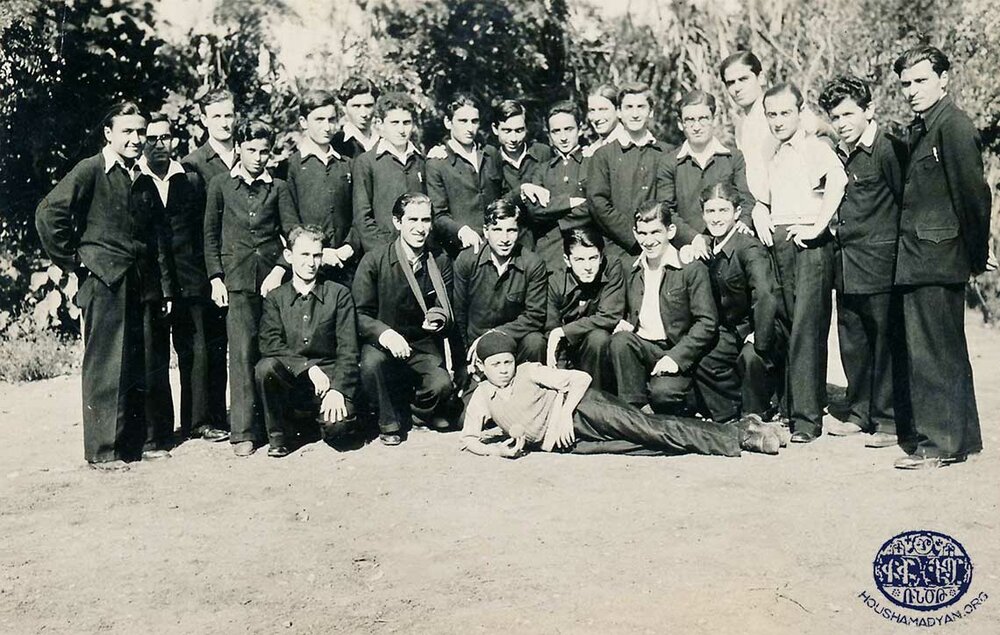
Kneeling, from left: 2nd - Panos Najarian, 4th - Armen Der Bedrosian, 5th - Hovsep Madenian, 6th - Kamer Basmadjian.
The selection of Seminary teachers and the drafting of the curriculum are also done with due diligence.
After the establishment of the library and the manuscript depository, the opening and furnishing of the Catholicosate’s printing house would be just as significant. Catholicos Papken succeeds in bringing a printing press from the NER orphanage in Athens, which had to be operated by foot due to lack of electrical equipment, and Armenian letters are ordered from Constantinople for shipment to the Kevorkian foundry. It is in this small printing house that the first issue of the Catholicosate's Hasg (Spike) official newspaper was published in January 1932. The first typesetters and printers were the Tbrevank students and, of course, the future young printing house owner Simon. It is in the newly established printing house, next to the library (Madenataran), that he finds his true “home”, immersing himself in the world of scrolls and books, satisfying his thirst for them to such an extent that Papken nicknames him the "little philologist", [12] while his classmates joke that “he smells like parchment.”
In reading and studying the manuscripts, Simonian finds realities that seem more intimate and charming than the deplorable situation of Armenian refugees in those days.
At the same time, the library and the printing house were to be joined by the kindergarten-preschool established in the courtyard of the Catholicosate, to serve the children of Armenian families in Antelias and the surrounding area and, at the same time, an experimental teachers’ school for the top Seminary students. This is where Simonian would experience his first attempts at teaching.
The library - printing house - school triangle created in Antelias, along with a taste for classical Armenian and literature and knowledge acquired from the teachers of the Tbrevank Armash school, in addition to his tireless efforts for self-improvement and self-propelled passion for study, would shape the future intellectual. Nshan Khoshafian, one of his Seminary classmates, once said that "when we graduated from the Tbrevank, Simon Simonian was already a historian-philologist and man of letters." [13]
Aleppo, 1930-1931. The Simonian family and relatives. The bald man sitting on the ground in foreground is Ové Simonian (Simon's father). To his right is Haroutiun Simonian (Simon's younger brother); to his right is Krikor Simonian (Simon's middle brother). The bald man, seated on the the far right, in the front row, is Djrji (Kevork) Giraco (Simon Simonian’s mother’s brother). Behind Djrji, a bit to the left, is Hagop Darakdji (later Giraco), Simon Simonian’s maternal grandfather. The religious woman sitting in the center is Sister Philomène Giraco (Simon Simonian's aunt). The woman seated to her right is Mennoush Simonian (Simon's mother). The rest are relatives of the Giraco, Shitilian, Kasbarian, Bodji and Simonian families.
- [1] Simon Simonian. A New Balladeer. Stepanos Dashtetsi study and poems. With seven unpublished poems of Naghash Hovnatan, [in Armenian] Sevan printers, Beirut, 1981, page 7.
- [2] This Simon Simonian study of Stepanos Dashtetsi's poems was separately published in Arshag Chobanian's edited Anahid magazine (Simon Simonian, Stepanos Dashtetsi: A New Ashugh (poems and study), Anahid Magazine, 1939, No. 3, April-May, pp. 51-68).
- [3] Simonian, A New Balladeer. Stepanos Dashtetsi, [in Armenian], page 128.
- [4] Ibid., p. 7.
- [5] This extract of the manuscript corresponds to page 77 of the printed book (Simonian, A New Balladeer: Stepanos Dashtetsi).
- [6] This extract of the manuscript corresponds to page 83 of the printed book (Simonian, A New Balladeer: Stepanos Dashtetsi).
- [7] This extract of the manuscript corresponds to page 86 of the printed book (Simonian, A New Balladeer: Stepanos Dashtetsi).
- [8] This extract of the manuscript corresponds to page 89 of the printed book (Simonian, A New Balladeer: Stepanos Dashtetsi).
- [9] Simon Simonian, The Mountaineers’ Last Twilight [in Armenian], Sevan printers, Beirut, 1968, page 207.
- [10] Spurk Weekly, October 13, 1966, page 1.
- [11] Hasg monthly newspaper, 55th years, No 3, March 3, 1986, Antelias, Lebanon, page 118.
- [12] Puzant Yeghiayan, Hasg periodical, March-April 1969, p. 134.
- [13] Nshan Khoshafian, Simon Simonian's The Mountaineers’ Last Twilight [in Armenian], Spurk Weekly, No. 24, June 7, 1970, Beirut, page 4.
